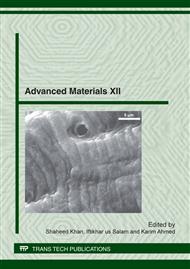p.43
p.51
p.58
p.67
p.75
p.80
p.89
p.98
p.105
Cerium Doped Bismuth Based High Tc Superconductor: Synthesis and Study of Superconducting Properties
Abstract:
High-Tc superconductivity has been an emerging field for researchers since its discovery. Bismith based superconductors commonly called BSCCO have great importance among the superconducting family. It is divided into three phases among them 2223 phase is highly studied in order to investigate its superconducting properties by substitution of different elements. We have studied the substitution of cerium (Ce) on calcium site of bismuth based Bi (Pb)Sr (Ba)-2223 high-Tc superconductor. The nominal compositions of Bi1.6Pb0.4Sr1.6Ba0.4(Ca1-xCex)2Cu3Ox ceramic superconductor were prepared by wet chemical method. Stoichiometric amounts of Bi2O3, PbO, Sr (NO3)2, BaCO3, CaCO3, CuO and CeO2 were used as starting materials. Structural analysis was done by X-ray diffraction (XRD) at room temperature and different parameters were calculated. DC resistivity measurements for the transition temperature of synthesized superconducting samples were taken by the standard four-probe method, apparatus for which was developed in our laboratory. It is observed that with the substitution of cerium on calcium site the single high-Tc 2223 phase is obtained.
Info:
Periodical:
Pages:
75-79
Citation:
Online since:
May 2012
Authors:
Keywords:
Price:
Сopyright:
© 2012 Trans Tech Publications Ltd. All Rights Reserved
Share:
Citation:



